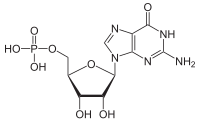| Revision as of 17:53, 19 March 2024 editMarbletan (talk | contribs)Extended confirmed users5,415 editsm →De novo synthesis← Previous edit | Latest revision as of 00:05, 29 April 2024 edit undo46.7.156.41 (talk) Changed nucleoside to nucleoside because GMP does include a phosphateTags: Mobile edit Mobile web edit | ||
| Line 42: | Line 42: | ||
| }} | }} | ||
| }} | }} | ||
| '''Guanosine monophosphate''' ('''GMP'''), also known as '''5′-guanidylic acid''' or '''guanylic acid''' (] '''guanylate'''), is a ] that is used as a ] in ]. It is an ] of ] with the ] ]. GMP consists of the ] ], the ] ] ], and the ] ]; hence it is a ] monophosphate. Guanosine monophosphate is commercially produced by microbial fermentation.<ref>{{cite web|url=http://www.vrg.org/blog/2011/03/21/disodium-inosinate-and-disodium-guanylate-are-all-vegetable-flavor-enhancers/|title=The Vegetarian Resource Group Blog|website=www.vrg.org|access-date=25 April 2018}}</ref> | '''Guanosine monophosphate''' ('''GMP'''), also known as '''5′-guanidylic acid''' or '''guanylic acid''' (] '''guanylate'''), is a ] that is used as a ] in ]. It is an ] of ] with the ] ]. GMP consists of the ] ], the ] ] ], and the ] ]; hence it is a ] monophosphate. Guanosine monophosphate is commercially produced by microbial fermentation.<ref>{{cite web|url=http://www.vrg.org/blog/2011/03/21/disodium-inosinate-and-disodium-guanylate-are-all-vegetable-flavor-enhancers/|title=The Vegetarian Resource Group Blog|website=www.vrg.org|access-date=25 April 2018}}</ref> | ||
| As an ] ], it takes the form of the prefix '''guanylyl-'''. | As an ] ], it takes the form of the prefix '''guanylyl-'''. | ||
Latest revision as of 00:05, 29 April 2024
Not to be confused with Cyclic guanosine monophosphate.
| |

| |
| Names | |
|---|---|
| IUPAC name 5′-Guanylic acid | |
| Systematic IUPAC name methyl dihydrogen phosphate | |
Other names
| |
| Identifiers | |
| CAS Number | |
| 3D model (JSmol) | |
| Abbreviations | GMP |
| ChEMBL | |
| ChemSpider | |
| ECHA InfoCard | 100.001.453 |
| E number | E626 (flavour enhancer) |
| IUPHAR/BPS | |
| MeSH | Guanosine+monophosphate |
| PubChem CID | |
| UNII | |
| CompTox Dashboard (EPA) | |
SMILES
| |
| Properties | |
| Chemical formula | C10H14N5O8P |
| Molar mass | 363.223 g·mol |
| Acidity (pKa) | 0.7, 2.4, 6.1, 9.4 |
| Except where otherwise noted, data are given for materials in their standard state (at 25 °C , 100 kPa).
| |
Guanosine monophosphate (GMP), also known as 5′-guanidylic acid or guanylic acid (conjugate base guanylate), is a nucleotide that is used as a monomer in RNA. It is an ester of phosphoric acid with the nucleoside guanosine. GMP consists of the phosphate group, the pentose sugar ribose, and the nucleobase guanine; hence it is a ribonucleotide monophosphate. Guanosine monophosphate is commercially produced by microbial fermentation.
As an acyl substituent, it takes the form of the prefix guanylyl-.
De novo synthesis
GMP synthesis starts with D-ribose 5′-phosphate, a product of the pentose phosphate pathway. The synthesis proceeds by the gradual formation of the purine ring on carbon-1 of ribose, with CO2, glutamine, glycine, aspartate and one-carbon derivatives of tetrahydrofolate donating various elements towards the building of the ring.

As inhibitor of guanosine monophosphate synthesis in experimental models, the glutamine analogue DON can be used.
cGMP
GMP can also exist as a cyclic structure known as cyclic GMP. Within certain cells the enzyme guanylyl cyclase makes cGMP from GTP.
cGMP plays an important role in mediating hormonal signaling.
Sources
GMP was originally identified as the umami substance in dried shiitake mushroom. The drying process significantly increases GMP content with the breakdown of RNA. It can be found in a number of other mushrooms.
Industrial production is based on fermentation: a bacterium converts sugars into AICA ribonucleotide, which is then converted chemically to GMP. Tapioca starch is a possible sugar source.
Food additive
Guanosine monophosphate is known as E number reference E626. In the form of its salts, such as disodium guanylate (E627), dipotassium guanylate (E628) and calcium guanylate (E629), are food additives used as flavor enhancers to provide the umami taste. It is often used in synergy with disodium inosinate; the combination is known as disodium 5′-ribonucleotides. Disodium guanylate is often found in instant noodles, potato chips and snacks, savoury rice, tinned vegetables, cured meats, and packet soup.
As it is a fairly expensive additive, it is usually not used independently of glutamic acid or monosodium glutamate (MSG), which also contribute umami. If inosinate and guanylate salts are present in a list of ingredients but MSG does not appear to be, the glutamic acid is likely provided as part of another ingredient, such as a processed soy protein complex (hydrolyzed soy protein), autolyzed yeast, or soy sauce.
See also
- Acceptable daily intake
- Disodium guanylate
- Disodium inosinate
- Inosinic acid
- Glutamate flavoring
- Kikunae Ikeda
- Umami
- Ajinomoto
- Tien Chu Ve-Tsin
- Glutamic acid
- Disodium glutamate
- Monopotassium glutamate
- Adenosine monophosphate
- Hypoxanthine-guanine phosphoribosyltransferase
- Ribonucleoside
References
- "The Vegetarian Resource Group Blog". www.vrg.org. Retrieved 25 April 2018.
- ^ Voet, Donald; Voet, Judith G. (2012). Biochemistry. USA: John Wiley & Sons Inc. pp. 1107–1109. ISBN 978-0-470-57095-1.
- Ahluwalia GS et al. Metabolism and action of amino acid analog anti-cancer agents ”, in Pharmac. Ther. (1990) 46: 243-271
- Kurihara, K (2015). "Umami the Fifth Basic Taste: History of Studies on Receptor Mechanisms and Role as a Food Flavor". BioMed Research International. 2015: 189402. doi:10.1155/2015/189402. PMC 4515277. PMID 26247011.
- Kinoshita, Kazumoto; Shiro, Teruo; Yamazaki, Akihiro; Kumashiro, Izumi; Takenishi, Tadao; Tsunoda, Toshinao (July 1967). "Industrial production of disodium 5?-guanylate". Biotechnology and Bioengineering. 9 (3): 329–342. doi:10.1002/bit.260090306. S2CID 84216811.
- Conn, Helen (1 February 1992). ""Umami": The Fifth Basic Taste". Nutrition & Food Science. 92 (2): 21–23. doi:10.1108/EUM0000000000953.
- ^ "Additive categories | CEFF". www.ceff.info. Retrieved 2021-11-30.
| Nucleic acid constituents | |||||||
|---|---|---|---|---|---|---|---|
| Nucleobase | |||||||
| Nucleoside |
| ||||||
| Nucleotide (Nucleoside monophosphate) |
| ||||||
| Nucleoside diphosphate | |||||||
| Nucleoside triphosphate | |||||||